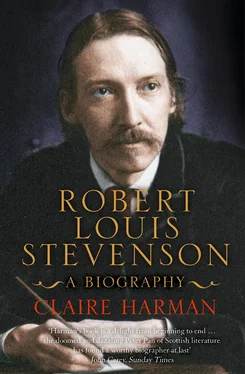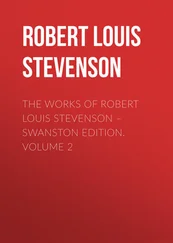Two things are immediately striking about this vivid account: one, that it anticipates so much of Stevenson’s most famous story, The Strange Case of Dr Jekyll and Mr Hyde – from the medical context, with its ‘monstrous malformations’ to the dismal cityscapes and degrading double-life; the other is the reappearance on every second flight of that endless upward staircase of a flaring ‘lamp with a reflector’, presumably stamped with the maker’s mark, ‘Stevenson and Sons’.
Stevenson implies that these nightmares ‘came true’ in as much as they hung so heavily on him during the day that he never seemed able to recover before it was time to resubmit to them. The account ends bathetically with the information that everything cleared up once he consulted ‘a certain doctor’ and was given ‘a simple draught’ (shades of Jekyll again), but what hangs in the reader’s mind, like the nightmare itself, is what Stevenson admits just before this, that the experience left ‘a great black blot upon his memory’ and eventually made him begin to doubt his own sanity.
In June 1869, Thomas Stevenson took his son with him on the annual tour of inspection aboard the lighthouse steamer Pharos , calling at Orkney, Lewis and Skye. There was plenty to fascinate Louis, but of a romantic, not a technical, nature. At Lerwick he heard all about tobacco and brandy smuggling, and at Fair Isle saw the inlet in which the flagship of the Armada had been wrecked: ‘strange to think of the great old ship, with its gilded castle of a stern, its scroll-work and emblazoning and with a Duke of Spain on board, beating her brains out on the iron bound coast’. 57 Not much survives apart from lists of his projected writings from this date, but they show another novel, sketches, stories and rough plans for at least eleven plays (listed in the notebook he took to P.G. Tait’s natural philosophy lectures, the only course he attended with any regularity). But the impression that his engineering experiences (or rather, the long observation of the sea and the Scottish coast they afforded) made on him fuelled his lifetime’s writing. It lies behind many of the autobiographical essays (‘The Coast of Fife’, ‘Rosa Quo Locorum’, ‘Memoirs of an Islet’, ‘On the Enjoyment of Unpleasant Places’, ‘The Education of an Engineer’), short stories such as ‘The Merry Men’, ‘Thrawn Janet’, ‘The Pavilion on the Links’, and the novels Treasure Island, Kidnapped and The Master of Ballantrae.
By the summer of 1870, when Louis was sent on his third consecutive engineering placement, he had begun to enjoy the trips much more. For one thing, there was plenty of sea travel, which he loved, and public steamers allowed him to charm and flirt with new acquaintances in a holiday manner. On the way to the tiny islet of Earraid, which the firm was using as a base for the construction of Dhu Heartach lighthouse, he met the Cumbrian artist Sam Bough, a lawyer from Sheffield, and a pretty and spirited baronet’s daughter called Amy Sinclair: ‘My social successes of the last few days [ … ] are enough to turn anyone’s head,’ he wrote home to his mother. 58 The party stopped at Skye and boarded the Clansman returning from Lewis, where their high spirits and monopolisation of the captain’s table were observed by a shy young tourist called Edmund Gosse, son of the naturalist P.H. Gosse, whose struggles to square fundamentalist religious views with the emerging ‘new science’ mirrored very closely those of Thomas Stevenson. Years afterwards, Gosse recorded his initial impressions of the young man who ‘for some mysterious reason’ arrested his attention: ‘tall, preternaturally lean, with longish hair, and as restless and questing as a spaniel’. 59 Gosse watched the youth on deck as the sun set, ‘the advance with hand on hip, the sidewise bending of the head to listen’. When the boat stopped unexpectedly a little while later, Gosse saw that they had come up an inlet and that there were lanterns glinting on the shore:
As I leaned over the bulwarks, Stevenson was at my side, and he explained to me that we had come up this loch to take away to Glasgow a large party of emigrants driven from their homes in the interests of a deer-forest. As he spoke, a black mass became visible entering the vessel. Then, as we slipped off shore, the fact of their hopeless exile came home to these poor fugitives, and suddenly, through the absolute silence, there rose from them a wild keening and wailing, reverberated by the cliffs of the loch, and at that strange place and hour infinitely poignant. When I came on deck next morning, my unnamed friend was gone. He had put off with the engineers to visit some remote lighthouse of the Hebrides. 60
What they were witnessing in the half-darkness was a latter-day form of Highland ‘clearance’, strongly similar to the notorious forced evictions of the eighteenth century. Stevenson does not mention Gosse at all or this incident in his letters home (which were too taken up with Miss Amy Sinclair), but it must surely be the inspiration for the scene in Chapter 16 of Kidnapped – written sixteen years later – when David Balfour sees an emigrant ship setting off from Loch Aline:
the exiles leaned over the bulwarks, weeping and reaching out their hands to my fellow-passengers, among whom they counted some near friends. [ … ] the chief singer in our boat struck into a melancholy air, which was presently taken up both by the emigrants and their friends upon the beach, so that it sounded on all sides like a lament for the dying. I saw the tears run down the cheeks of the men and women in the boat, even as they bent at the oars. 61
Earraid itself, where Stevenson was headed on the Clansman , figured prominently in Kidnapped as the isle of Aros, on which David Balfour believes himself to be stranded. It was his first view of Earraid, isolated and empty except for one cotter’s hut, that Stevenson reproduced in the novel; when the firm was there in 1870, the islet had been transformed into a bustling work-station, with sheds, a pier, a railway, a quarry, bothies for the workmen, an iron hut for the chief engineer and a platform on which parts of the lighthouse were preconstructed. The reef where the lighthouse was to be built, fifteen miles away, was watched through a spyglass, and when the water was low, the engineers would put out for it in a convoy of tenders and stone-lighters. The scene on Dhu Heartach was another one of industrial despoliation: ‘the tall iron barrack on its spider legs, and the truncated tower, and the cranes waving their arms, and the smoke of the engine-fire rising in the mid-sea’. 62
Stevenson’s letters home to his parents from Earraid were typically charming, affectionate and frank. He sought to be a good son, and bore his parents’ feelings in mind to an extraordinary degree, perhaps too much for his own good. He did not share all their values by any means, found many of their strictures infuriating or risible, deceived them to the usual degree in such cases, yet felt what amounts to a profound sympathy for their predicament qua parents and never ceased to respect and love them. ‘It is the particular cross of parents that when the child grows up and becomes himself instead of that pale ideal they had preconceived, they must accuse their own harshness or indulgence for this natural result,’ he wrote in an uncollected essay. 63 ‘They have all been like the duck and hatched swan’s eggs, or the other way about; yet they tell themselves with miserable penitence that the blame lies with them; and had they sat more closely, the swan would have been a duck, and home-keeping, in spite of all.’ 64 Thus he continued – for the time being – to be a staunch religionist (writing to the approved Church of Scotland paper on subjects such as foreign missions), a good Tory (he was treasurer of the University Conservative Club in 1870) and a passable student of engineering. But it couldn’t last long, and didn’t.
Читать дальше












